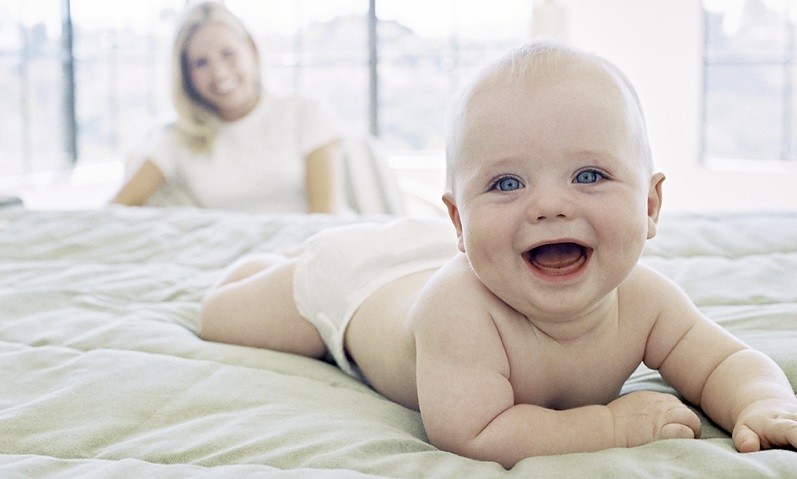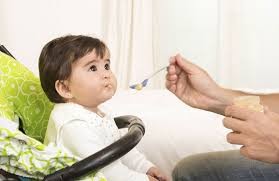The World Health Organization recommends exclusive breastfeeding for up to 6 months. Then, in addition to breast milk, you should begin to inject complementary foods to all children, regardless of the type of feeding.
The first lure is either vegetable puree or porridge. It is one-component, homogeneous and must be introduced gradually. The fact that we began to give the child a lure does not prevent breastfeeding. If you have introduced vegetables into the first lure, then you should enter the porridge in the second lure (or vice versa).
6 months is the most frequent time of the onset of active teething. However, they can erupt both earlier and later than this time. In some children, teeth begin to erupt only closer to the year and this is normal, too.
The first incisors are lower incisors. They can appear together, and can one after another. After the appearance of the first tooth, they must be cleaned 2 times a day with a soft baby toothbrush. This is not only hygiene, but also the child's training to the fact that the teeth need to be cleaned 2 times a day, and one of the rituals of packing.
The child already clearly distinguishes people - his-others. It is unlikely that he will go to the hands of a stranger as calmly as before. Most likely, he will simply tear himself apart. This is an absolutely normal reaction, a protective instinct, not his capriciousness.
The baby sleeps less. Active wakefulness time can reach 2.5 hours. Often the child remains up to 6 months of 3-day sleep (can be 1 long sleep and 2 short). During the waking period, it requires more and more attention, and my mother may become tired from this.
Some babies by this age are able to sleep all night and give their mother a good sleep. However, others, on the contrary, wake up quite often. This can be a reaction to teething.
♦ Is able to stretch his arms in the supine position, hold this position for a long time, pull up his legs and bend them at the knees, trying to get on all fours.
♦ Some already know how to crawl and get on all fours and swing back and forth.
♦ An active speech appears, which is still a collection of sounds and syllables.
♦ Takes a toy from various positions.
♦ He laughs in his voice.
The emotional development of the child is very important. Favorite toys, books with large pictures - all this causes his enthusiastic delight. As often as possible, read his favorite tales, and soon he will start to remember them and respond with a smile to the familiar beginning.
Motor development
A child who lay a month ago on his stomach and could only pull out his hands and lift his chest slightly above the floor, now can already get up on all fours, and sometimes crawl (even on his stomach and not far away).
Some children start sitting on their own in 6 months. So now the time of active movement of the child begins. Do not leave the baby alone on the bed and if left on the floor, then as much as possible secure the surrounding space.
The child actively plays with toys, easily shifts them from hand to hand. He thundered with a rattle, knocking toys on the floor.
How to play with a child in 6 months
At this age, it is easy to develop the child's hearing. Various ringing, jangling boxes, squeaking toys - everything attracts him.
Pay attention: toys should be safe (including in size) so that the baby cannot swallow or inhale them, because of the main method of knowing the child surrounding things - through the mouth. Everything, that is possible, he suffices and tries on taste.
Favorite game of children "Ladushki" - an excellent variant of development of motor skills. The child tries to hit the palm with the palm of his hand under the song. It develops including coordination of movements.
The child already knows how to double and triple syllables - this is the initial development of speech. These attempts to speak should be actively supported by parents. Repeat several times to the child of the names of these or other objects. You can try to conduct with the kid a kind of "dialogue", answering him with his active babble and supporting such a conversation.
The child already focuses his eyes well and does not cross his eyes. He can follow the rolling ball or watch the fast enough movements of the older brother playing nearby.
You can see how the kid is focused looking at the toy that is in his hand. Improves the coordination of hands and eyes. Notice how he first looks at the object and then tries to crawl to it.
Babies learn about the world through touch. When you hug or kiss your child, he realizes that he is in safety and love. When your child feels a cool breeze on his cheek, he learns about the world around him.
The possibilities for developing your baby's tactile sensations at this age are endless even during a typical day. The kid will play with toys and books, with things having a different texture surface. See if your child likes to touch a soft plush toy or feel the texture of the carpet. Let the kid safely explore the world around him.
Do not forget that it is important for a child to feel safe with his parents and know about it. Kiss, hug the children as often as you can, they become stronger from this.


